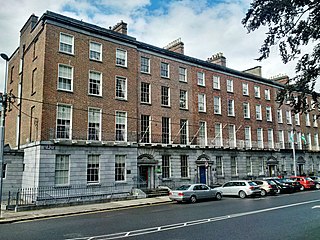
Limerick is a city in western Ireland, in County Limerick. It is in the province of Munster and is in the Mid-West which comprises part of the Southern Region. With a population of 94,192 at the 2016 census, Limerick is the third-most populous urban area in the Republic of Ireland, and the fourth-most populous city on the island of Ireland at the 2011 census. It was founded by Scandinavian settlers in 812, during the Viking Age.

Waterford is a city in County Waterford in the south-east of Ireland. It is located within the province of Munster. The city is situated at the head of Waterford Harbour. It is the oldest and the fifth most populous city in the Republic of Ireland. It is the ninth most populous settlement on the island of Ireland. Waterford City and County Council is the local government authority for the city. According to the 2016 Census, 53,504 people live in the city, with a wider metropolitan population of 82,963.

The Irish Georgian Society is an architectural heritage and preservation organisation which promotes and aims to encourage an interest in the conservation of distinguished examples of architecture and the allied arts of all periods across Ireland, and records and publishes relevant material. The aims of this membership organisation are pursued by documenting, education, fundraising, grant issuance, planning process participation, lobbying, and member activities; in its first decades, it also conducted considerable hands-on restoration activities.

As with other cities in Ireland, Limerick has a history of great architecture. A 1574 document prepared for the Spanish ambassador attests to its wealth and fine architecture:
The architecture of Ireland is one of the most visible features in the Irish countryside – with remains from all eras since the Stone Age abounding. Ireland is famous for its ruined and intact Norman and Anglo-Irish castles, small whitewashed thatched cottages and Georgian urban buildings. What are unaccountably somewhat less famous are the still complete Palladian and Rococo country houses which can be favourably compared to anything similar in northern Europe, and the country's many Gothic and neo-Gothic cathedrals and buildings.

Limerick railway station also known as Colbert Station or Limerick Colbert serves the city of Limerick in County Limerick. It is on Parnell Street and is the main station on the Limerick Suburban Rail network. It has approximately 2,500 rail passengers a day travelling on four rail routes. The Bus Éireann bus station on site services approximately one million passengers a year, with 125 buses departing each day.

O'Connell Street is the main thoroughfare of the city of Limerick. It was previously known as George's Street until it was renamed after Daniel O'Connell. The street runs in parallel to the River Shannon and forms part of an overall thoroughfare, along with Rutland Street and Patrick Street, that bisects Limerick City Centre in a north east to south west direction. The street is about a mile in length, starting at the Arthurs Quay / Denmark Street junction and ending at The Crescent. A monument to Daniel O'Connell stands at the centre of The Crescent overlooking O'Connell Street. The street is noted for its Georgian architectural heritage.

Edmund Sexton Pery, 1st Viscount Pery was an Anglo-Irish politician who served as Speaker of the Irish House of Commons between 1771 and 1785.

The People's Park is a park located by Pery Square in Limerick, Ireland, just west of the railway station and bus terminal. At the northern edge of the park is the Limerick City Gallery of Art.

Limerick Museum, previously known as the Jim Kemmy Municipal Museum, is a city museum in Limerick, Ireland.

Newtown Pery is an area of central Limerick, Ireland, and forms the main city centre of the city. The district is known for its Georgian architectural heritage and is the core area of Limerick's Georgian Quarter. It is one of the three towns that make up modern-day Limerick City Centre, the other two being the older Englishtown and Irishtown, which date from the medieval period. Newtown Pery houses the largest collection of Georgian townhouses in Ireland outside of Dublin. In 1837, Samuel Lewis in his Topographical Dictionary of Ireland described Newtown Pery as "one of the handsomest towns in Ireland".

Pery Square is a Georgian Terrace located in the Newtown Pery area of Limerick city, Ireland. The terrace was constructed as a speculative development by the Pery Square Tontine Company between 1835 and 1838. The square was named in honour of the politician Edmund Sexton Pery. The terrace is notable as one of the finest examples of late Georgian architecture in Limerick and Ireland.
Davis Ducart, was an architect and engineer in Ireland in the 1760s and 1770s. He designed several large buildings and engineering projects. He had associations with the canal builders of the time and the mining industry and worked on many projects in the County Tyrone coalfield.
Sharon Slater is an Irish historian and author. Her work primarily focuses on the history of Limerick, Ireland using the name Limerick's Life. Following a mentorship from Frank Prendergast she attended the University of Limerick and received an MA in Local History.

The Dublin Civic Trust is an architectural conservation and educational organisation founded in 1991 that works to identify, record, preserve and publicise Dublin's architectural heritage. The trust also comments and assists to a lesser extent with other buildings outside of Dublin.

The People's Museum of Limerick is a local history museum in Limerick, Ireland.
The Irish Heritage Trust is an architectural and cultural organisation which aims to preserve, maintain and understand notable Irish buildings for the purposes of education, research and recreation. The organisation was founded in 2006 as Ireland's national, independent, heritage property organisation in a similar model to that of the National Trust in the U.K.













